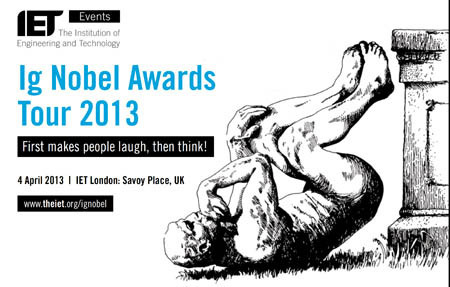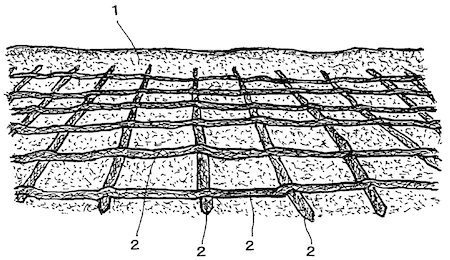Marc Abrahams's Blog, page 502
April 5, 2013
Unexpected poster versions of scientists’ names
This is one of :
The web site explains:
To celebrate the Science Day in India, Mumbai-based graphic designer Kapil Bhagat created a series of minimalist typographic posters featuring the names of famous scientists. Each design cues to an invention, a theory or an achievement that the scientist is known for. For example, Newton drops an “O” to illustrate gravity, a massive “C” in Copernicus reminds us that he figured the Earth wasn’t the center of the universe and placed the Sun, rather than the Earth, at the center.
(Thanks to Diana Issidorides for bringing this to our attention.)

In reply to quacks who quibble dramatically over duck details
Patricia Brennan writes, in Slate:
Why I Study Duck Genitalia
In the past few days, the Internet has been filled with commentary on whether the National Science Foundation should have paid for my study on duck genitalia, and 88.7 percent of respondents to a Fox news online poll agreed that studying duck genitalia is wasteful government spending. The commentary supporting and decrying the study continues to grow. As the lead investigator in this research, I would like to weigh in on the controversy and offer some insights into the process of research funding by the NSF….
(Thanks to Laura Bassett and other investigators for bringing this to our attention.)
BONUS: A new look back at homosexual necrophilia in the mallard duck

Headline o’ the day: “Brazil Nut Effect Measured in Lunar and Martian Gravity Conditions”
Today’s Headline of the Day appears in The Physics arXiv Blog:
Brazil Nut Effect Measured in Lunar and Martian Gravity Conditions
The headline concerns the also-intriguingly-headlined study
“Granular convection and the Brazil nut effect in reduced gravity,” Carsten Güttler [pictured here], Ingo von Borstel, Rainer Schräpler, Jürgen Blum,” arXiv:1304.0569, Apr 2, 2013. The authors report:
“We present laboratory experiments of a vertically vibrated granular medium consisting of 1 mm diameter glass beads with embedded 8 mm diameter intruder glass beads. The experiments were performed in the laboratory as well as in a parabolic flight under reduced-gravity conditions (on Martian and Lunar gravity levels). We measured the mean rise velocity of the large glass beads and present its dependence on the fill height of the sample containers, the excitation acceleration, and the ambient gravity level. We find that the rise velocity scales in the same manner for all three gravity regimes and roughly linearly with gravity.”
(Thanks to investigator Peppe Liberti for bringing it to our attention.)

April 4, 2013
Extending Bullshit Studies – more from Academia
 Emeritus Professor Harry Frankfurt’s essay-that-turned-into-a-book ‘On Bullshit’ (see Annals of Improbable Research, March | April 2009, volume 15, number 2, p. 25 ) set the stage for further academic research on the subject of BS. And now the field has been explored further with a paper in College English, Vol. 73, No. 3, January 2011, Rhetoric and Bullshit. In which author, Professor James A. Fredal, of the Department of English at The Ohio State university, coins a (possibly) new term – “Taurascatics”.
Emeritus Professor Harry Frankfurt’s essay-that-turned-into-a-book ‘On Bullshit’ (see Annals of Improbable Research, March | April 2009, volume 15, number 2, p. 25 ) set the stage for further academic research on the subject of BS. And now the field has been explored further with a paper in College English, Vol. 73, No. 3, January 2011, Rhetoric and Bullshit. In which author, Professor James A. Fredal, of the Department of English at The Ohio State university, coins a (possibly) new term – “Taurascatics”.
“The study of bullshit should occupy an important place alongside rhetoric because taurascatics is the antistrophe of rhetorical theory, for both are concerned with the politics of semiotic interaction, and with the frameworks within which that interaction will be produced, interpreted, and judged.”
The professor examines in turn :
• The Bullshitter (the originator of the BS)
• The Bullshit, (the content), and
• The Bullshitee (the recipient).
And provides examples of the kind of BS one might encounter on a daily basis : e.g.
• “Collateral damage” for civilians accidentally killed in military actions.
• “Rightsizing” for firing people, and
• “Alternative interrogation techniques” for torture.
Also see:
“Deeper into Bullshit.” from the late professor G.A. Cohen, All Souls, Oxford. (Contours of Agency: Essays on Themes from Harry Frankfurt. Ed. Sarah Buss and Lee Overton. Cambridge: MIT P, 2002.)
Notes:
• Many thanks to professor Fredal for his assistance.
• The Logo is taken from the header of professor Cohen’s paper.
• The Bullshit Gazette is, sadly, no longer in print

Ig Nobel show Thursday at the IET in London (and live webcast)
The Institute of Engineering and Technology (IET) is hosting a big Ig Nobel show Thursday night (4 April), beginning at 6:00 pm.
It’s in the IET Building on Savoy Place (not far from Charing Cross), beginning at 6:oo pm.
The event is FREE (and also, we are told, unfettered) — but you’d best book reservations.
The event will also be WEBCAST LIVE.
Paper airplanes will be on hand, and in the air. The show features:
Marc Abrahams , organizer of the annual Ig Nobel Prize Ceremony
Siobhan Abeyesinghe (Do hens have friends?)
Charlotte Burn (Study of canine tail-chasing and human responses to it)
Dan Schreiber (Improbable things I researched for The Museum of Curiosity and QI )
Chris McManus, Ig Nobel Prize winner (Scrotal asymmetry in man and ancient sculpture). Professor McManus also will reveal the results of his recent, delicate Danish inquiry.
This is a featured event in the 2013 Ig Nobel Tour of the UK.
BONUS (after the event occurred): recorded video of the event

April 3, 2013
Adventures with a straw checkerboard paving robot
News (in the form of a published study) about straw checkerboard paving robots:
“Dynamics analysis on transverse cutting mechanism of straw checkerboard paving robot,” Sciences in Cold and Arid Regions, Yu Ye, ShuFa Sun and JinHao Liu, 4(5), 2012, pp. 0439~0445. (Thanks to investigator Tom Gill for bringing this to our attention.)
Straw checkerboard paving has its roots in the soil, perhaps needless to say. A recent patent shows a new twist on the method, while explaining briefly what that method is and why strawboard checkerboard supporters support the use of straw checkerboarding:
“Sand drift prevention method, method of forming and improving vegetation in…“, US patent # 8113739, issued February 14, 2012, to Osamu Mito, Kazuya Matsumura, Koji Sasaki, Takenobu Okumura, Shigeto Matsumoto, Makoto Maeda. It says:
“A sand drift prevention method in which a plurality of columnar sandbags made of a tubular knit fabric are placed so as to cross over one another, and in such a pitch that 3 to 30 sandbags are disposed for every ten meters, and in which the cross-sectional area of each of the columnar sandbags is 10 to 400 cm2. A method of forming and improving the vegetation in sandy soil in which drift of sand is prevented by the sand drift prevention method, a plant desired to grow is grown in the sandy soil surface exposed as being surrounded by columnar sandbags placed so as to cross over one another.”
The patent document flaunts this explanatory drawing:

Ig Nobel show Thursday at the IET in London (and live webcast)
The Institute of Engineering and Technology (IET) is hosting a big Ig Nobel show Thursday night (4 April), beginning at 6:00 pm.
It’s in the IET Building on Savoy Place (not far from Charing Cross), beginning at 6:oo pm.
The event is FREE (and also, we are told, unfettered) — but you’d best book reservations.
The event will also be WEBCAST LIVE.
Paper airplanes will be on hand, and in the air. The show features:
Marc Abrahams , organizer of the annual Ig Nobel Prize Ceremony
Siobhan Abeyesinghe (Do hens have friends?)
Charlotte Burn (Study of canine tail-chasing and human responses to it)
Dan Schreiber (Improbable things I researched for The Museum of Curiosity and QI )
Chris McManus, Ig Nobel Prize winner (Scrotal asymmetry in man and ancient sculpture). Professor McManus also will reveal the results of his recent, delicate Danish inquiry.
This is a featured event in the 2013 Ig Nobel Tour of the UK.

April 2, 2013
Fish: Dolphins ‘dolphin-kick’ better than humans
Dr. Fish of Westchester University not only specialises in manta rays and whales, [see previous post; Dr. Fish, Dr. Watts and their cetacean tubercules] he also investigates dolphins. In collaboration with Alfred von Loebbecke, Rajat Mittal and Russell Mark, Dr. Fish examined : ‘Propulsive Efficiency of the Underwater Dolphin Kick in Humans’ (Journal of Biomechanical Engineering, May 2009, Vol. 131)
The experimental team found that the mean propulsive efficiency of underwater dolphin-kicks in humans is a comparatively underwhelming 29%, whereas the mean propulsive efficiency of a typical cetacean is an impressive 56%.
A slightly later paper by the same authors in Human Movement Science 28 (2009) 99–112 ‘A comparison of the kinematics of the dolphin kick in humans and cetaceans‘ offered a convincing explanation as to why this might be happening :

“The underperformance (as measured by number of kicks per body length travel) of human swimmers when compared to cetaceans is a consequence of their anatomy and musculature.”

Advanced brain research using Neo-Nazis and a cup
Research about the brain tries to measure — and interpret — ever-more-complex kinds of phenomena. Dr. Aziz-Zadeh tells, in a recorded talk for Academic Minute, about an advanced investigation:
…looking at the brain activity of Jewish individuals while they watched videos of Anti-Semetic Neo-Nazis performing simple actions, like reaching for a cup.
BONUS: the 2012 Ig Nobel Prize for neuroscience was awarded to Craig Bennett, Abigail Baird, Michael Miller, and George Wolford, for demonstrating that brain researchers, by using complicated instruments and simple statistics, can see meaningful brain activity anywhere — even in a dead salmon.
[REFERENCE: "Neural correlates of interspecies perspective taking in the post-mortem Atlantic Salmon: An argument for multiple comparisons correction," Craig M. Bennett, Abigail A. Baird, Michael B. Miller, and George L. Wolford, poster, 15th Annual Meeting of the Organization for Human Brain Mapping, San Francisco, CA, June 2009.]
[REFERENCE: “Neural Correlates of Interspecies Perspective Taking in the Post-Mortem Atlantic Salmon: An Argument For Multiple Comparisons Correction,” Craig M. Bennett, Abigail A. Baird, Michael B. Miller, and George L. Wolford, Journal of Serendipitous and Unexpected Results, vol. 1, no. 1, 2010, pp. 1-5.

“Corpse Treatment Method”: The body of a tree, so to speak and also literally
This patent application describes how to use a human corpse to grow part of a copse:
“Corpse Treatment Method,” U.S. Patent Application 12/160,699, Evert Dirk Van Ramshorst, filed January 15, 2007.
“A new form of corpse treatment has also been developed: freeze-drying or lyophilization. In freeze-drying the body of the deceased is cooled to -18° C. The frozen body is then immersed in a bath of liquid nitrogen. The frozen body then becomes very fragile. By then subjecting it to vibrations, the body falls apart into a kind of powder from which the moisture is then extracted by means of vacuum. A dry, odourless powder with a weight in the order of 25 to 30 kg eventually remains.
“EP-A-0 623 717 proposes to have the ashes of the deceased taken up in a plant, usually a tree, so that a living monument is obtained as a memory of the deceased. The ash is here placed in the vicinity of roots of the plant. Washing of the ash out of the ground will however generally take place much more quickly than the absorption of the ashes by the plant, so that only a small part of the ash will actually be taken up into the living plant. It is an object of the invention to provide a method for corpse treatment wherein the greatest possible part of the bodily remains is absorbed into the plant.”
The search for this patent was inspired by David Brooks (the good David Brooks, not the one in the NY Times), when asked, in his blog, “Do maple trees near cemeteries have sap that tastes like corpses?”
BONUS: Evert van Ramshorst (deceased)

Marc Abrahams's Blog
- Marc Abrahams's profile
- 14 followers






